Synovex S (Canada)
This treatment applies to the following species:STEER IMPLANTS
DIN 00262056
For increasing weight gain and feed efficiency in steers weighing 185-450 kg.
Veterinary Use Only
Active Ingredients: Each implant (contents of one cartridge cell) contains:
200 mg Progesterone,
20 mg Estradiol be benzoate.
Directions For Use
For subcutaneous ear implantation only. Implant complete contents of one cartridge cell (one implant) per steer. The proper implantation technique is fully described in the enclosed leaflet.
SYNOVEX S implants contain two steroid hormones, progesterone and estradiol benzoate. SYNOVEX S helps speed up the steer’s weight gaining mechanism and help produce higher weight gains per kilogram of feed. SYNOVEX S is recommended for use in steers weighing 185 to 450 kg. The weight increase is dependent on the quality of the animal and the feed. Maximum growth will be attained with good quality stock that is free from parasitism and disease.
Instructions
Study the following instructions carefully, then proceed step by step, until the technique becomes routine. Many heads can be implanted per hour by an experienced team, one member of which should be assigned to do nothing but the implantation. Keep hands clean and use sanitary instruments only.
 |
WarningsDo not use in calves to be processed for veal. Implant SYNOVEX in the ear only; any other location may result in condemnation of the carcass. Do not attempt to salvage the implanted ear for human or animal food. Keep out of reach of children. |
 |
Step 1 Loading The Implanter
Load the implanter following the directions outlined in the instruction manual accompanying each implanter.
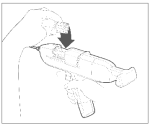
Step 2 Restraint
The animal must be confined in a restraint mechanism (squeeze chute or head gate). The implant site on the back of the ear should be prepared by scrubbing with a generous-sized piece of cotton that has been soaked in a germicidal solution.
Note: If implanting horned cattle, greater safety is provided when the head is controlled by the use of a bull lead (nose tongs).
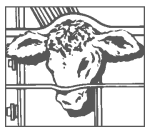
Step 3 Implant Site
Divide the ear into three imaginary sections as illustrated. The implanted pellets should be deposited in the center one-third of the ear as shown. To accomplish this, the implanter needle should be inserted in the outer one-third of the ear as indicated by the “X” in the illustration. Implanting too close to the head may cause bulling. Care should be taken to avoid severing the major arteries of the ear.
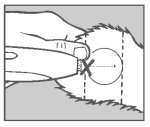
Step 4 Insert Needle
Grasp the ear with one hand. Holding the implanter firmly with the other hand, penetrate the skin at the point shown by the “X”. Thrust the needle under the skin, taking care not to penetrate the cartilage. Ease the implanter forward (toward the base of the ear) until the full needle length is beneath the skin.
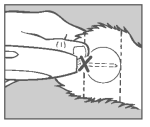
Step 5 Pellet Implantation
When the needle is completely inserted activate the instrument by backward pressure on the trigger. Do not withdraw the needle, but allow the automatic needle retractor to release the pellets. This will allow the pellets to be deposited in a straight line in the path of the retracted needle.
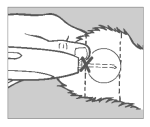
Step 6 Inspection
Check the implant site. If properly administered, the implants should lie in a straight line under the skin.
Disinfect the implanter needle in a germicidal solution and recock the instrument by rotating the cocking grip left, pull back, rotate right, then push all the way forward. You are now ready to implant the next animal.
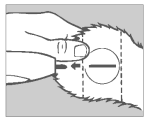
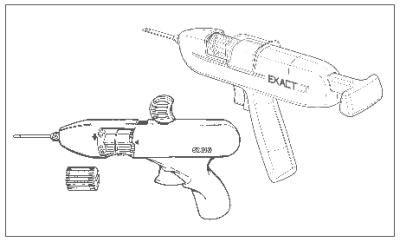
IMPORTANT: Proper cleansing of skin implantation area and the use of a clean implanter will prevent skin infection. When inserting needle, keep it just beneath the skin - do not allow needle point to injure the ear cartilage. If implantation is performed during the fly season, use a fly repellent on needle insertion area following pellet implantation.
CAUTIONS: Bulling, rectal prolapse, ventral edema and elevated tailheads have occasionally been reported in steers implanted with SYNOVEX S.
CONTRAINDICATIONS: SYNOVEX S is not recommended for use in staggy (bulling) or extremely restless animals. Not intended for use in breeding animals.
Good management practice is to separate “bullers” from the herd.
Storage
Store between 20 and 25°C with excursions between 15 and 30°C. Avoid freezing, sunlight, excessive heat and humidity.NET 100 IMPLANTS
Zoetis® and Synovex are registered trademarks of Zoetis or its licensors.
Zoetis Canada Inc., Kirkland QC H9H 4M7
2022-10-2
40043446
CPN: 1198410.4
16,740 TRANS-CANADA HIGHWAY, KIRKLAND, QC, H9H 4M7
| Order Desk: | 800-663-8888 | |
| Technical Services Canada: | 800-461-0917 | |
| Technical Services USA: | 800-366-5288 | |
| Website: | www.zoetis.ca |
 |
THIS SERVICE AND DATA ARE PROVIDED "AS IS". Animalytix assumes no liability, and each user assumes full risk, responsibility, and liability, related to its use of the Animalytix service and data. See the Terms of Use for further details. |

Copyright © 2024 Animalytix LLC. Updated: 2024-08-26
